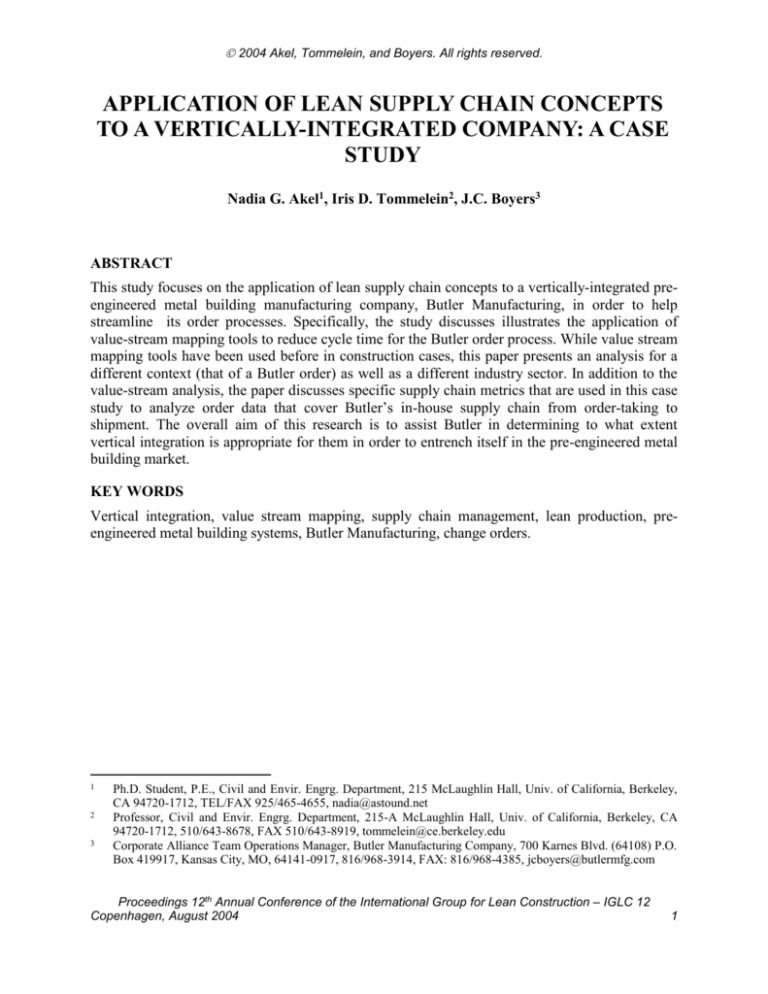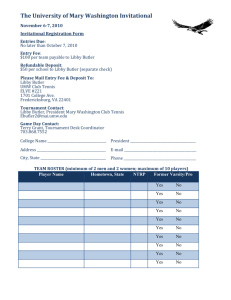
2004 Akel, Tommelein, and Boyers. All rights reserved.
APPLICATION OF LEAN SUPPLY CHAIN CONCEPTS
TO A VERTICALLY-INTEGRATED COMPANY: A CASE
STUDY
Nadia G. Akel1, Iris D. Tommelein2, J.C. Boyers3
ABSTRACT
This study focuses on the application of lean supply chain concepts to a vertically-integrated preengineered metal building manufacturing company, Butler Manufacturing, in order to help
streamline its order processes. Specifically, the study discusses illustrates the application of
value-stream mapping tools to reduce cycle time for the Butler order process. While value stream
mapping tools have been used before in construction cases, this paper presents an analysis for a
different context (that of a Butler order) as well as a different industry sector. In addition to the
value-stream analysis, the paper discusses specific supply chain metrics that are used in this case
study to analyze order data that cover Butler’s in-house supply chain from order-taking to
shipment. The overall aim of this research is to assist Butler in determining to what extent
vertical integration is appropriate for them in order to entrench itself in the pre-engineered metal
building market.
KEY WORDS
Vertical integration, value stream mapping, supply chain management, lean production, preengineered metal building systems, Butler Manufacturing, change orders.
1
2
3
Ph.D. Student, P.E., Civil and Envir. Engrg. Department, 215 McLaughlin Hall, Univ. of California, Berkeley,
CA 94720-1712, TEL/FAX 925/465-4655, nadia@astound.net
Professor, Civil and Envir. Engrg. Department, 215-A McLaughlin Hall, Univ. of California, Berkeley, CA
94720-1712, 510/643-8678, FAX 510/643-8919, tommelein@ce.berkeley.edu
Corporate Alliance Team Operations Manager, Butler Manufacturing Company, 700 Karnes Blvd. (64108) P.O.
Box 419917, Kansas City, MO, 64141-0917, 816/968-3914, FAX: 816/968-4385, jcboyers@butlermfg.com
Proceedings 12th Annual Conference of the International Group for Lean Construction – IGLC 12
Copenhagen, August 2004
1
2004 Akel, Tommelein, and Boyers. All rights reserved.
INTRODUCTION
This research investigates lean supply chain practices at Butler. Butler engineers, designs,
manufactures, and erects pre-engineered metal buildings and components both domestically and
internationally. The Butler supply chain comprises supply in-house, reaching from one functional
division (e.g., design) into another (e.g., fabrication). It also reaches outside of the organization,
upstream to third-party vendors and downstream to independent contractors. The company’s
vertically integrated nature creates a unique opportunity with regards to improved supply-chain
practices in the otherwise fragmented AEC industry. For instance, Butler is able to fabricate all
primary and secondary structural steel components of a 100,000 ft2 building in a 13-day time
window after release of detail drawings.
Butler offers a variety of pre-engineered metal buildings, ranging from more standardized,
modularized designs to 100% custom designs. Standardization and modularization create unique
opportunities for efficient supply chain practices. The researchers, jointly with their Butler
sponsor, therefore decided to study these most standardized products, which Butler calls the Acell buildings, particularly since A-cell buildings comprise 60% of Butler’s orders. A-cell
buildings are based on a kind of parametric design that allows for customization while also
considering efficiency and cost-effectiveness of fabrication. While Butler’s product takes
advantage of Butler’s in-house design and fabrication capabilities, information and materials do
not flow as smoothly as they could across internal organizational boundaries. As a result, the
product lead time from order taking to materials delivery on site is larger than it could be, when
considerations for continuous flow are taken into account.
The purpose of this case study is therefore to explore the benefits of applying lean production
and supply chain management practices to Butler. The study focuses on Butler’s supply chain
practices with regards to the design and fabrication of its A-cell buildings in order to investigate
the possibilities of achieving closer alignment between Butler’s design/manufacturing arm and its
construction arm. This entails identifying internal hand-offs and buffers, and then creating flow
and implementing other lean practices in Butler and its subsidiaries. Alignment may be achieved
by implementing lean production principles not only within but also across organizational
boundaries.
BUTLER BACKGROUND
Butler performs the design of its pre-engineered metal buildings in-house because the required
structural engineering knowledge in cold-formed steel design is neither widely taught nor readily
available. In fact, Butler has engineering design offices in each of its six U.S. manufacturing
facilities to serve regional markets. In recent years, the pre-engineered metal building industry
has moved from modular, fully standardized buildings to custom buildings. Butler has followed
that move but many of its processes rely on parametric designs so that the company can still take
advantage of modularity in its order-taking, materials-procurement, and fabrication processes.
Butler brings its building systems’ products to market through various agreements with
general contractors. It sells its materials predominantly through two construction channels—
Butler Builders, a network of local, independent general contractors authorized to sell and erect
Butler Buildings, and Butler Construction (BUCON), Butler’s own construction arm. Butler’s
two main types of distributors serve different construction markets and therefore do not compete
with each other. Akel et al. (2001) describes Butler’s organization and distributor network in
further detail. Tommelein et. al. (2003) describes Butler’s supply chain process in greater detail
than this paper.
Proceedings 12th Annual Conference of the International Group for Lean Construction – IGLC 12
Copenhagen, August 2004
2
2004 Akel, Tommelein, and Boyers. All rights reserved.
BUTLER ORDER DATA
While this case study focuses on Butler as a national corporation, most of the data was obtained
in working with personnel at their Visalia, CA plant. This choice was driven largely by proximity
of this plant to U.C. Berkeley (4.5 hour drive each way) but also by the fact that personnel at this
plant already took significant effort in mapping their processes and implementing lean production
practices. Such practices consistently lead to improved supply chain performance.
The data for the value stream mapping analysis are based on 21 actual Butler Visalia Pronto
orders. These are all the Butler Pronto orders for a single, larger-sized Butler Builder placed in
2001. These 21 orders correspond to 18 projects in the California Central Valley. Therefore, for
the most part, each of these Butler Builder projects corresponds to one Butler order. From all the
data, there was one Builder project that was broken down into three Butler orders.
METRICS
At its production facilities, Butler uses three main metrics: value added time (VAT),
manufacturing cycle time (or throughput time), and manufacturing lead time. These terms are
defined below along with other supply chain metrics that are used in this case study to analyze
order data that cover Butler’s in-house supply chain from order-taking to shipment. The
definitions used here are from Hopp and Spearman (2000), the Supply Chain Operations
Reference (SCOR) Model Metrics (SCOR 2000), and the Lean Construction Institute (LCI
2002).
Cycle Time [unit of time]: The time for a product to go from the beginning to end of a production
process; i.e., the time the product spends as work-in-process (Hopp96, Lean02). Cycle time
includes three components: (1) value-added time, (2) setup time, and (3) wait time; these are
defined next. Butler refers to cycle time as the manufacturing lead time (MLT). Butler also uses
manufacturing cycle time (MCT) to denote VAT and Setup Time.
Cycle Time = VAT + Setup Time + Wait Time = MLT = MCT + Wait Time
Value-Added Time (VAT) [unit of time]: The time necessary to actively work (design, engineer,
fabricate, etc.) on an item (such as a project design, a beam, a clip, etc.). The time spent to
perform a conversion task. VAT does not include setup or wait time.
Setup Time [unit of time]: Time it takes to change over and ready a machine or production unit
to start the next task or operation.
Queue Time [unit of time]: Wait time. The time that an item is sitting around waiting in a queue.
Throughput (or Throughput Rate) [unit of quantity/unit of time]: The average output rate of a
production process (machine, workstation, line, plant) per unit time (e.g., parts per hour)
(Hopp96, Lean01). The limit on the throughput is the capacity.
Capacity [unit of quantity/unit of time]: an upper limit on the throughput of a production process
(Hopp and Spearman 2000 p. 216).
Schedule Plan Stability: The number of times the scheduled delivery date changed after it was
fixed once it appeared within the critical time fence. The critical time fence defines the moment
in time after which changes to the order become significantly more expensive to accommodate
than they were, had they been made earlier (e.g., materials that were obtained and partially
Proceedings 12th Annual Conference of the International Group for Lean Construction – IGLC 12
Copenhagen, August 2004
3
2004 Akel, Tommelein, and Boyers. All rights reserved.
completed may become obsolete). It is the boundary between flexible and fixed capacity SCOR
(2000).
Delivery Performance to Scheduled Commit Date: The percentage of orders that are fulfilled on
or before the original scheduled or committed date (SCOR 2000).
ANALYSIS AND OBSERVATIONS
VALUE STREAM ANALYSIS: BUTLER ORDER PROCESS
Value stream mapping is used by the Toyota Production System practitioners to depict current
and future, or “ideal,” states in the process of developing implementation plans to install lean
systems. A value stream analysis of the Butler order process was performed in order to assess
information and material flow, to identify the sources of waste, and to help visualize the entire
order process. Per Rother and Shook (1998), Brunt (2000), Rother and Harris (2001), and Jones
and Womack (2002), a value stream consists of all the actions (both value and non-value added)
currently required to bring a product through the main flows essential to every product: (1) the
production flow from raw material into the arms of the customers, and (2) the design flow from
concept to launch.
Value Stream Map: Current-State
To create the value stream map for Butler’s order process (Figure 1), an order was followed from
the point at which an order is placed by a Builder to the point at which the Butler product is
shipped to the construction site. The value-adding steps are shown as rectangles, and the handoffs with delays are shown as triangles.
1
2
5 days
Project
Order
Assigned
3
2 weeks (not including permit delays)
Engineering
Design
Screen
Order
1 mh (assumed)
4 mh for standard projects
Design
Check
Permits
Engineering
Detailing
2 mh
2 wk to 2 yr
16 mh
4
3 weeks
Shipment
on Site
Ship
Average Total Value-Added Time
Average Total Queue & Setup Time
Fabrication
Engineering
Release to
Manufacturing
3-4 days
0 mh (assumed)
= 1.28 weeks (6.375 days , 1.6 - 12.8% of total)
= ~9-79 weeks (87.2 - 98.4% of total)
Average Total Actual Time in System = 10-80 weeks (100%)
Proceedings 12th Annual Conference of the International Group for Lean Construction – IGLC 12
Copenhagen, August 2004
4
2004 Akel, Tommelein, and Boyers. All rights reserved.
Figure 1: Value Stream Map of Butler Visalia’s Order Process. Circled numbers correspond to
the process lead time descriptions in Table 2. (adapted from Tommelein 2003)
The value stream map in Figure 1 shows activity durations (in total man-hours [mh] of work
content) and lead time estimates provided by Butler personnel. The “average total actual time in
system”estimated average lead time of a Butler order from the point the order is assigned to the
actual ship date. In contrast to Figure 1, Figures 2-6 show planned and actual lead times from the
Butler order data. Table 1 summarizes relevant statistical calculations for these figures. Note that
original planned dates are the dates set prior to change orders, while revised planned dates
correspond to planned dates that have been amended via change order.
An interesting observation is that the estimates provided by Butler personnel (in Figure 1) are
relatively close to the mode (most-likely) values calculated from the Butler order data. This is
primarily due to the fact that the distributions are all highly-skewed (Figures 2-6). For example,
the mode duration for the planned design activity is only 1 day, which is very close to Butler
Visalia’s estimate of 6 man-hours (4 hours for engineering design and 2 hours for design check).
However, the average duration is much larger at 6.7 calendar days since it accounts for the
outliers. Due to the skewed nature of these lead time distributions, Butler personnel properly
used mode values as these do not account for the rare case of having an unusually long duration.
10
12
Planned
Planned
10
Actual
8
Actual
Frequency
4
2
6
4
2
0
36
33
30
27
24
21
18
15
9
Order Assigned to Design Start Lead Tim e (days)
12
6
0
42
39
36
33
30
27
24
21
18
15
9
12
6
3
0
0
3
Frequency
8
6
Design Duration (days)
Figure 2
Figure 3
10
10
Planned
Original Planned
Actual
8
Revised Planned
8
Frequency
Frequency
Actual
6
4
2
6
4
2
0
0
0
3
6
9
12
15
18
21
24
27
Permit and Detail Engineering Duration (weeks)
Figure 4
30
0
3
6
9
12
15
18
21
24
Engineering Release to Ship Date (weeks)
Figure 5
Proceedings 12th Annual Conference of the International Group for Lean Construction – IGLC 12
Copenhagen, August 2004
5
2004 Akel, Tommelein, and Boyers. All rights reserved.
3
Original Planned
Revised Planned
Actual
Frequency
2
1
0
0
3
6
9
12
15
18
21
24
27
30
33
36
Order Assigned to Ship Date Lead Time (weeks)
Figure 6
The time required to obtain permits depends on the location and the number of projects that that
city is processing—hence, the 2-week to 2-year range provided by Butler personnel in Figure 1 .
In Los Angeles, for example, permits take roughly 9 months to procure. In contrast, permits can
be obtained in about 3 weeks in a small municipality such as Visalia. The Butler order data
analyzed had a mode of 1 week and an average of 12 weeks.
Table 1: Statistical calculations for Butler order process times
PROCESS LEAD TIME DESCRIPTIONS
1
2
3
4
Order Assigned to Planned Design Start (days)
Order Assigned to Actual Design Start (days)
Planned Design Duration (days)
Actual Design Duration (days)
Planned Permit & Engineering Detail Duration (weeks)
Actual Permit & Engineering Detail Duration (weeks)
Planned ERD to Original Planned Ship Date (weeks)
Planned ERD to Revised Planned Ship Date (weeks)
Actual ERD to Actual Planned Ship Date (weeks)
Order Assigned to Original Planned Ship Date (weeks)
Order Assigned to Revised Planned Ship Date (weeks)
Order Assigned to Actual Planned Ship Date (weeks)
Average
Standard Deviation
Mode
10.2
12.8
6.7
3.7
12.0
12.0
3.3
5.0
8.8
17.3
19.0
22.8
7.1
11.2
9.8
5.5
10.6
10.7
0.9
2.8
6.7
11.1
11.0
10.0
6
6
1
<1
1
1
3.4
5.0
2.6
9.7
11.3
28.1
FIGURE
2
3
4
5
6
* Circled numbers to the right of table correspond to those in Figure 1.
By comparing the data estimated by Butler personnel in the value stream map in Figure 1 to the
actual order data in Table 1, performance metrics can be assessed. The total VAT in Figure 1
was shown to be roughly 1.28 weeks. This is 1.6 to 12.8% of the total estimated lead time (LT).
When compared to actual order data, the VAT/LT is roughly 5.6% as shown in Table 2.
To compare the value-added time to other sectors of the construction industry, Arbulu and
Tommelein (2002) showed that VAT/LT is on the order of 3.5 to 4% for the power plant pipe
support supply chain. Similarly, Elfving et. al. (2002) indicated that VAT is less than 10% of
total LT in power distribution supply chains and that it can be radically improved (Elfving 2003).
Hopp and Spearman (2000, p. 327) identify that “In most production systems, actual process and
move times are a small fraction (5-10 percent) of total cycle time.” Anecdotal evidence in lean
construction shows that VAT/LT is on the order of 1/20 (5%) for design and 1/10 – 3/10 (1030%) for fabrication but those are merely rule of thumbs.
Proceedings 12th Annual Conference of the International Group for Lean Construction – IGLC 12
Copenhagen, August 2004
6
2004 Akel, Tommelein, and Boyers. All rights reserved.
Table 2: Percentage of Value-Added Time for overall Butler order process times (adapted from
Tommelein 2003)
from
Order Assigned
Order Assigned
Order Assigned
Lead Time [weeks]
to
Original Planned Ship Date
Revised Planned Ship Date
Actual Ship Date
VAT
LT
7.4%
6.7%
5.6%
From the anecdotal evidence, it seems that Butler’s value stream can be appreciably streamlined
since its VAT/LT ratio is on the low end at 5.6%, especially when considering that this number is
for their standard parametric designs. Improvements can be made by reducing queue time and
setup times in the overall system. Increasing VAT up to 20% of LT has been done in
manufacturing and is a reasonable aim. In fact, one of the aims of supply chain management
should be to increase the value of this ratio to 20% if not more (Tommelein 2002).
Table 2 shows value-added times to lead time ratios computed using actual plant data. These
include three sets of values, corresponding to (1) the original plan, (2) the revised plan, and (3)
actual execution. Not surprisingly, the VAT/LT ratio is higher when considered planned times as
opposed to actual times because planners tend to be optimistic and eventually schedules slip.
MANUFACTURING LEAD TIMES
Figure 7 illustrates the value-added time (shown in green), setup time (yellow), and queue time
(red) for various components fabricated at the Visalia plant. The total manufacturing lead time is
comprised of the green, yellow, and red bars shown in the figure. Note that the bars shown are
not drawn to scale.
As encountered in the previous section, VAT is a very small percentage of the total
manufacturing lead time for all the components, with exception of the secondaries. The VAT/LT
ratio varies greatly for different components. Primaries have an average ratio of 0.5% while wall
roof panels have a ratio of 0.02%! In contrast, secondaries are more efficiently produced with a
ratio of 25-50%.
Primaries
38
Secondaries
2
Connections
1 4
Clips
2-6
Few hrs-days
6-7
3-14
Brace Rods
Manufactured
Component
2
2140-50
2095-4195
6-8
800 pieces/week
1500-1750 pieces/week
250 pieces/week
4800
1.5 3.5
1440-2880
3000 pieces/week
Wall/Roof Panels 11
Ridge Caps
4280-5720
1430
VAT (min/item)
500,000 - 1,500,000 lineal feet/week
1575 pieces/week
3000 pieces/week
Setup Time (min/item)
Queue Time (min/item)
Production Capacity
Figure 7: Manufacturing lead time information for material fabricated at Butler Visalia
Proceedings 12th Annual Conference of the International Group for Lean Construction – IGLC 12
Copenhagen, August 2004
7
2004 Akel, Tommelein, and Boyers. All rights reserved.
Figure 7 also shows the weekly plant production capacity for each component. For example, the
Visalia plant can fabricate 800 primary components weekly. To get an appreciation of the
production capacity of the various components, Figure 8 shows a material take-off for a small
Butler building with a 60’ by 1000’ footprint. For purposes of comparison, most Butler Builder
buildings are on the order of 50,000 to 100,000 square feet (Akel 2001).
The Visalia plant typically processes 25-30 orders per week. Sometimes, the Visalia plant
will handle more or less, depending on customer demand. Typically, there are 8-9 jobs ongoing
at any one time. The Visalia plant itself has enough capacity to manufacture 700-800 frames
pieces per week. For comparison purposes, a 100,000 square-foot building consists of
approximately 200 frame pieces.
The basic elements of any pre-engineered metal building system are constant: primary rigid
frames, secondary members (wall girts and roof purlins), cladding and bracing (Shoemaker
1999). The secondary members are usually cold-formed into C and Z shapes. The primary frames
are designed using welded plate members instead of the hot-rolled sections used in conventional
steel design. This practice permits the use of tapered beam sections. By varying the web depth
and flange size over the length of a member, pre-engineered metal manufacturers can produce
designs that are more cost effective than their conventional steel counterparts.
ridge cap
300-400
wall/roof panels
connections
clips
60’
100’
400 secondaries
50 primaries
10 brace rods
Figure 8: A widespan Butler building with a 60’ x 100’ footprint. [Nadia to do actual takeoff]
Proceedings 12th Annual Conference of the International Group for Lean Construction – IGLC 12
Copenhagen, August 2004
8
2004 Akel, Tommelein, and Boyers. All rights reserved.
BATCHING
The hand-off from design to fabrication—governed by Butler’s proprietary, computer-aided
design system, named Pronto—is still traditional and batch-oriented. Opportunities for process
improvement are to be investigated in this area.
The batching rules in Figure 2 reveal the hand-offs for a particular Pronto project. First,
unless a project has completely regular plan and elevation views—i.e., a rectangular-shaped
building with no mezzanine—it is broken down into multiple ‘regular-shaped’ orders for Pronto
design purposes. Second, a Butler order is then broken down into manifests—one for each
fabrication location and outside suppliers. Third, an internal Butler manifest is then broken into
phases for production scheduling purposes. Finally, once the fabrication is completed and Butler
receives the supplies from its suppliers, the order is then reassembled and again broken down
into transportation manifests. Such batch-oriented hand-offs (Figure 2) cause matching problems,
thereby rendering the order process less efficient.
Butler Builder
Project is
divided into
Pronto Orders
Pronto Order is
divided into
Fabrication
Manifests
Manifest is
divided into
Production Phases
if > 75,000 ft2 or if >
110 frame pieces
Completed
Project is
divided into
Transportation
Manifests
Figure 9: Batch-Oriented Hand-Offs for Butler Builder projects
CHANGE ORDER ANALYSIS: SCHEDULE PLAN STABILITY
Of the 21 Butler Pronto orders analyzed in this case study, 11 (52%) had change orders. The
number of change orders per Butler order ranged from 0 to 6, with the average being 1.19. All
change orders, with the exception of one, were for postponing planned ship dates and/or
engineering release dates. While the percentage of projects with change orders seems high,
changes relating to planned ship dates are normal and relatively common in the construction
industry. Assuming that all the planned ship date changes were made within the critical time
fence, the Schedule Plan Stability for the Butler orders analyzed was therefore 1.14. Note that the
Schedule Plan Stability is less than the number of change orders per Butler order of 1.19. This is
due to the fact that some change orders did not affect the time fence.
Figure 9 compares and contrasts the total delivery time of orders that did not have change
orders (‘A’) with those that did (‘B’). The dotted red bars show the duration of permitting and
detail engineering. Since detail engineering has a value added time of 16 mh while the bars are
on the order of 8-15 weeks, we can conclude that the bars primarily represent permitting delays.
Several observations can be made about the data. However, please note that our observations are
speculative and are based on a small number of data points (21).
Permitting has a long lead time that can be reduced significantly: Most striking is the large
variation in duration needed for permitting, in particular because the projects analyzed are all
built in the same geographic area. The planned time required to get a permit is about 15.5 weeks
for orders without changes, and slightly over half of that, 8 weeks, for orders with changes.
Barring regional and design differences, we speculate that orders with changes are ‘on the fast
track’ and require permit expediting, which may be done either for a fee, or simply by more
active expediting, or the like.
Proceedings 12th Annual Conference of the International Group for Lean Construction – IGLC 12
Copenhagen, August 2004
9
2004 Akel, Tommelein, and Boyers. All rights reserved.
A. Butler Orders without Change Orders
Planned
13.1d
5.6d
15.5w
3.4w
21.7w
Actual
13.6d
3.9d
15.7w
6.1w
24.4w
B. Butler Orders with Change Orders
Planned 7.3d
7.5d
Original 3.2w
Revised 6.6w
8.0w
Original 12.9w
Revised 16.3w
Actual
12.0d
3.5d
7.9w
11.4w
21.1w
INDEX:
Actual
or
Planned
Order Assigned to Design
Start Lead Time
[calendar days]
Design Duration
[calendar days]
Permit and Detail
Engineering Duration
[weeks]
Engineering Release to
Ship Date Lead Time
[weeks]
total duration [weeks]
Figure 10: Butler orders with and without change orders
Figure 10-5 may give the impression that permitting drives the start of engineering detailing and
of fabrication further downstream, but the drawing does not show other supply chains feeding
into this one, such as the supply of materials. A reduction in the time for permitting and thus
between design and fabrication, may constrain the time available for materials procurement,
mobilization, and stocking. Performance improvements for those tasks are then needed in order
to make it possible for fabrication to start earlier.
It is difficult to jump start the delivery process: While the planned Order-Assigned to
Design Start time for ‘B’ orders shaves 5 days off from what is custom for ‘A’ orders, in practice
that lead time is close to what it is for ‘A’ orders anyway. Some of that lost time in ‘B’ orders
(‘lost’ meaning the difference between planned and actual) appears to be made up by less time
spent on design: the planned value of these two combined is 7.3 d + 7.5 d = 14.8 d and the actual
value 12.0 d + 3.5 d = 15.5 d. These values are a few days less than their counterparts for ‘A’
orders, 18.7 d and 17.5 d respectively.
Note that in both cases ‘A’ and ‘B’, the actual design time is less than the planned design
time. It is the only task shown in Figure 10-9 for which this is the case. We speculate that the
resources required to perform design are underloaded sufficiently so that they can accommodate
‘urgent’ demands without too much difficulty. Underloading means that a resource is not
scheduled to work at 100% capacity at all times, but instead at 80% or 90% depending on the
variability in work flow. Underloading is a management technique for creating reliability in work
flow and throughput in systems that are subject to variability. Underloading should make it
feasible to estimate durations more accurately, but the practice of padding schedules is deeply
engrained.
Fast-track jobs create turbulence downstream: In each case ‘A’ and ‘B,’ orders with
changes saw an escalation of Engineering-Release to Ship-Date, with actual values being nearly
double that of planned values. Moreover, ‘B’ orders had an actual value that is significantly
larger than ‘A’ orders. Provided that it is correct to assume that orders with changes are on the
fast track, a question then is how to manage changes while not jeopardizing fabrication?
Proceedings 12th Annual Conference of the International Group for Lean Construction – IGLC 12
Copenhagen, August 2004
10
2004 Akel, Tommelein, and Boyers. All rights reserved.
Normal delivery is more reliable; fast-track delivery is plagued by uncertainty: For ‘A’
orders, the planned overall average duration (from order assigned to ship date) is closer to the
actual than for ‘B’ orders. This discrepancy is primarily due to the fact that orders with COs have
a much longer actual average engineering release to ship date lead time (11.4w) than orders
without COs (6.1w). This suggests that change orders adversely affect fabrication scheduling,
thereby hampering its ability to deliver the product in a reasonable manner.
Schedules always slip: For all Butler orders (those with or without COs), actual ship dates
exceed original and revised planned ship dates by several weeks, about 3 weeks for ‘A’ orders
and about 5 weeks for ‘B’ orders. This suggests that Butler Plant's fabrication scheduling can be
improved so that planned dates are less optimistic and closer to actual dates.
DELIVERY PERFORMANCE TO SCHEDULED COMMIT DATE
Of the 21 orders analyzed, only 17 had information relating to actual ship dates. Among these,
only 4 were fulfilled (actual delivery) on or before the original planned ship date. Therefore, the
Delivery Performance to Scheduled Commit Date ratio is a mere 4/17 or 23.5%. The actual ship
date of these four orders coincided exactly with the original planned ship date, so that none of the
4 were shipped early.
The percentage of orders that were fulfilled within a week and three from the original
planned ship date is 41.2% (7/17) and 47.1% (8/17), respectively. In order to better comprehend
the reasons behind the poor estimation of original planned ship dates, Butler should compile the
reasons for failure and a conduct a root cause analysis.
LESSONS LEARNED
Several lessons are learned from analyzing the Butler case and its desire to succeed:
Elasticity in production capacities: Since frame production is usually the fabrication
constraint at the Visalia plant, Butler always runs frame production (primary steel fabrication
and its associated connections) at this plant 3 shifts per day, 5 days per week. The other
materials typically do not run at capacity. These typically run on 1 or 2 shifts per day,
depending on the component produced and demand for that component. This elasticity in the
production capacity (by controlling the number of shifts used per day) to accommodate
market variability has helped Butler maintain competitive delivery schedules while mitigating
costs of non-critical production activities.
Modularization and its impact on the production process (supply chain): By categorizing
designs according to degree of project customization, Butler was able to improve the
efficiency of its design function and fine-tune it to take advantage of its fabrication
capabilities.
Serving customer needs – supplier design for constructability or mistake-proofing (pokayoke): Butler spends considerable time and effort learning from its Builders and BUCON
what the degree of constructability is of their products. The company invests heavily in
research and development in order to make its products more appreciated by building erectors
as well as owner-operators. For example, Butler worked with an upstream supplier to
engineer a new kind of sealant (a putty-like material with tiny cubes in it) that a worker
cannot compress too much during installation (doing so would squeeze the material out from
the joint and thereby prevent sealing action). This putty material comes is rolled with layers
Proceedings 12th Annual Conference of the International Group for Lean Construction – IGLC 12
Copenhagen, August 2004
11
2004 Akel, Tommelein, and Boyers. All rights reserved.
separated in easily removable, non-tear plastic strips, and one side of the strip is precut
lengthwise to allow for easy positioning of a screw through it.
Gaining insight into product demand: In recent years, Butler has established a Corporate
Alliance group that courts large owners, users of large Butler buildings. Because these
owners have facilities around the country, sometimes even around the world, no Builder is in
a position to serve them consistently. Butler’s Alliance group was formed exactly for that
reason. In developing a close relationship with them, Butler also is gaining insight into
upcoming demands for their products, which is of course extremely valuable from a
production viewpoint.
Standardization: Butler has been able to provide a relatively short made-to-order delivery
time by standardizing products, automating large parts of the design process, maintaining
approximately 3-month worth of inventories, and distributing production capabilities around
the country so as to be close to delivery locations.
CONCLUSIONS AND RECOMMENDATIONS
Although Butler is proactive about improving its processes, its application of lean production
resides primarily at the plant level. By applying lean production principles across its internal
functional divisions, Butler can realize additional improvements, in areas such as:
Batching: The batching process from order-to-phase-to-manifest could be improved to
facilitate flow. The design information may not be needed all at once (as Pronto demands
now), given that only some information is needed to start production. For example, the
primary structurals can be designed first and released into production while the design of
secondaries is under way. By releasing the time-critical production of the primary steel
members, the overall design and fabrication duration of the entire project may be reduced.
Furthermore, primary structurals also are the members needed first in construction so this resequencing of work may also benefit further downstream operations. Butler should reconsider
how projects are broken up in pieces (batches) that define the various units for design,
document generation, fabrication, and shipping and streamline that process with work flow
and the final unit of handoff to the contractor in mind,
Transparency: Butler can improve transparency across its internal functions and across its
supply chain in order to tighten the rules-of-thumb that are currently used to replenish
inventories. For example, Butler can be clearer about what is needed when, so that when
deadlines are missed, the impact on production is better understood. Butler can also make its
production process more transparent to its construction customers (the Builders and BUCON)
without necessarily giving away its competitive advantage. This way, it would perhaps be
able to penalize its customers for late changes.
Synchronization, One-Piece Flow, and Pull: Butler could further study the time its
employees spend especially on soliciting and rectifying customer order data. This process
presently appears to be extremely time consuming and subject to variability so that it takes
away from Butler’s design and fabrication efficiency. A suggestion is for Butler to decouple
order taking from design. Similarly, the permitting process appears to be extremely time
consuming and subject to variability. This process should be decoupled from design
(upstream) and fabrication (downstream). Butler should then work towards aiming for
continuous flow in each of these four de-coupled production phases.
Production Balancing: Butler’s design and fabrication processes were mapped using symbols
that represent value-adding work as well as ‘holding’ positions (a.k.a., transfer points,
Proceedings 12th Annual Conference of the International Group for Lean Construction – IGLC 12
Copenhagen, August 2004
12
2004 Akel, Tommelein, and Boyers. All rights reserved.
queues, inventories, waiting lines, etc.) Each process step was defined in terms of its valueadded time, setup time, and queue time. It appears as though the various production steps all
progress at their own pace with relatively little consideration for the pace of other processes
that are part of the same sequence or whose outputs merge at a later time. The production
system as a whole, across design through fabrication, has not been balanced. This lack of
balancing has many reasons, which have to do with variability and risk.
Alliances: Butler currently has longer-term procurement agreements in place for structural
steel. These were not investigated in the study, but they may be worth looking into by Butler
to further improve SC performance.
Horizontal Integration: Butler has bought other supplier firms (doors and window suppliers)
but it is not clear to what extent these products or processes have been streamlined to
integrate with Butler’s products and processes.
Process Maps: Butler should further detail the process maps that have been created in the
course of this research to identify additional opportunities for SC improvement from a total
systems perspective.
Array of Products Produced: Butler should reconsider what it is producing at each of its 6
fabrication plants. Presently, all plants can make all primary and secondary steel components,
albeit in a limited set of colors (some plants offer a wider selection than others), but some
cannot make trim components such as eaves, gutters, etc. Butler must therefore ship such
components between plants. It is quite possible that the cost to invest in tools and equipment
to make these components in small quantities is not prohibitive, and would offset the cost of
inter-plant transportation. (The decision to ship between plants may be driven by Butler’s
past investment in fully automated but expensive production facilities, whose costs must be
offset by high volumes of production.)
ACKNOWLEDGEMENTS
Many thanks are due to all people interviewed, for the time they spent and knowledge they
shared with us. The authors are deeply indebted to J.C. Boyers, Operations Manager in Butler’s
Corporate Alliance Team, for the wealth of information he has provided relating to Butler’s
organization, and operations, and data for this case study. This research project would not have
been possible without J.C.’s continued assistance.
The authors would particularly like to thank Greg Stolze, Butler Visalia’s Plant Manager, for
sharing his knowledge and expertise regarding the operations and demands of Butler’s Visalia
plant. The authors would also like to individually thank Alice Brown, Cathy Drennen, Keith
Neill, Mark Nore, Anthony Portugal, and Chris Pursifull at Butler Visalia; Charles Milburn and
Cliff Robertson at Butler’s Research Center in Kansas City; Brent Holt and John Tucker at
Butler’s Kansas City Headquarters; Bill Johnsmeyer, Gary Dixon, Darrell Freeman, Darren
Hiley, Jack Hott, Vivian Kieslich, Bob Knapp, Dan Mitchell, Doug Pettijohn, Kenny Strope, and
Paul Wildschuetz at Butler Construction in Kansas City; and Ellis Daniels at Valley Steel
Construction in Fresno for generously sharing their specialized knowledge and experience in the
pre-engineered metal building industry.
This research was funded in part by a grant for task force PT 172 “Improving Construction
Supply Chain Performance” from the Construction Industry Institute whose support is gratefully
acknowledged. The opinions presented herein are those of the authors and not necessarily reflect
those of the Construction Industry Institute.
Proceedings 12th Annual Conference of the International Group for Lean Construction – IGLC 12
Copenhagen, August 2004
13
2004 Akel, Tommelein, and Boyers. All rights reserved.
REFERENCES
Akel, N.G., Boyers, J.C., Tommelein, I.D., Walsh, K.D., and Hershauer, J.C. (2001).
"Considerations for Streamlining a Vertically Integrated Company: A Case Study." Ninth
Annual Conference of the International Group for Lean Construction (IGLC-9), 6-8 August
2001, Singapore.
Arbulu, R.J., and Tommelein, I.D. (2002). “Value Stream Analysis of Construction Supply
Chains: Case Study on Pipe Supports Used in Power Plants.” Tenth Annual Conference of the
International Group for Lean Construction (IGLC-10), 6-8 August 2002, Brazil.
Brunt, D. (2000) “From Current State to Future State: Mapping the Steel to Component Supply
Chain.” The International Journal of Logistics: Research and Applications, 3 (3) 259-271.
Elfving, J.A., and Tommelein, I.D., and Ballard, G. (2003). “An International Comparison of the
Delivery Process of Power Distribution Equipment.” Eleventh Annual Conference of the
International Group for Lean Construction (IGLC-11), 22-24 July 2003, Virginia.
Elfving, J.A., and Tommelein, I.D., and Ballard, G. (2002). “Reducing Lead Time for Electrical
Switchgear.” Tenth Annual Conference of the International Group for Lean Construction
(IGLC-10), 6-8 August 2002, Brazil.
Hopp, W.J., and Spearman, M.L. Factory Physics: Foundations of Manufacturing Management.
Irwin/McGraw-Hill, Boston.
Jones, D. and Womack, J. (2002). Seeing the Whole – Mapping the Extended Value Stream.
March, The Lean Enterprise Institute, Brookline, MA, 97 pages.
Lean (2002). Lean Construction Institute Glossary. http://www.leanconstruction.org. Visited
April 20, 2002.
Rother, M. and Harris, R. (2001). Creating Continuous Flow – An Action Guide for Managers,
Engineering, and Production Associates.. V. 1.0, June, The Lean Enterprise Institute,
Brookline, MA, 104 pages.
Rother, M. and Shook, J. (1998). Learning to See: Value Stream Mapping to Add Value and
Eliminate Muda. V. 1.1, October, The Lean Enterprise Institute, Brookline, MA, 106 pages.
SCOR (2000). Supply Chain Operations Reference (SCOR) Model, Supply Chain Council, Inc.,
Pittsburg, PA, Version 3.1, March 2000. www.supply-chain.org
Shoemaker, W.L. (1999). “Metal Building Systems: A New Look.” Civil Engineering, June, 69
(6) 56-59.
Simchi-Levi, D., Kaminsky, P., and Simchi-Levi., E. (2000) Designing and Managing the Supply
Chain: Concepts, Strategies, and Case Studies. Boston, MA, McGraw Hill.
Supply Chain Operations Reference (SCOR) Model, Supply Chain Council, Inc., Pittsburg, PA,
Version 3.1 March 2000. www.supply-chain.org
Tommelein, I.D., Walsh, K.D., and Hershauer, J.C. (2003). “Improving Capital Projects Supply
Chain Performance.” Construction Industry Institute Research Report 172-11, May 2003,
University of Texas at Austin.
Proceedings 12th Annual Conference of the International Group for Lean Construction – IGLC 12
Copenhagen, August 2004
14








